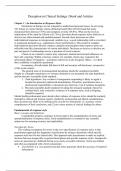Deception in Clinical Settings | Book and Articles
Chapter 1 | An Introduction to Response Styles
Deceptions in therapy are not relegated to undisclosed personal issues. In surveying
547 former or current therapy clients, Blanchard and Farber (2016) found that many
minimized their distress (53.9%) and symptom severity (38.8%). What are the two key
implications of the study by Ellison et al.? First, decisions about response styles (disclose or
deceive) are often rational and multidetermined. Second, these decisions are often
individualised responses to interpersonal variables (e.g., a good relationship with a coworker)
or situational demands (e.g., explanation of poor performance). This model of complex,
individualized decisions directly counters a popular misconception that response styles are
inflexible trait-like characteristics of certain individuals. Decisions to deceive or disclose are
part and parcel of relationships across a spectrum of social contexts.
Clients in an evaluative context may experience internal and external influences on
their self- reporting. Within a forensic context, for example, clients may respond to the
adversarial effects of litigation—sometimes referred to as the lexogenic effects—in which
their credibility is implicitly questioned.
In summary, all individuals fall short of full and accurate self-disclosure, irrespective
of the social context.
The general issue of inconsequential deceptions should be considered carefully.
Simply as a thought experiment, two extreme alternatives are presented: the taint hypothesis
and the beyond- reasonable doubt standard.
1. Taint hypothesis: Any evidence of nongenuine responding is likely to signal a
broader but presently undetected dissimulation. Therefore, practitioners have a
professional responsibility to document any observed, even if isolated, deceptions.
2. Beyond-reasonable-doubt standard: Invoking the stringent standard of proof in
criminal trials, only conclusive evidence of a response style, such as feigning,
should be reported.
Mental health professionals must decide what evidence of response styles should be routinely
included in clinical and forensic reports. Guided by professional and ethical considerations,
their decisions are likely to be influenced by at least two dimensions: (1) accuracy versus
completeness of their conclusion, and (2) use versus misuse of clinical findings by others.
Fundamentals of response style
Basic concepts and definitions
Considerable progress continues to been made in the standardization of terms and
operationalization of response styles. Such standardization is essential to any scientific
endeavour for ensuring accuracy and replicability.
Non-Specific Terms
The working assumption for errors in the over-specification of response styles is that
practitioners approach this diagnostic classification by trying to determine which specific
response style best fits the clinical data. This approach asks practitioners to make an explicit
decision between nonspecific or general descriptions and specific response styles. Nonspecific
terms are presented in a bulleted format as an easily accessible reference. Terms are defined
and often accompanied with a brief commentary:
• Unreliability is a very general term that raises questions about the accuracy of reported
information.
, • Nondisclosure simply describes a withholding of information (i.e., omission). Similar
to unreliability, it makes no assumptions about intentionality.
• Self-disclosure refers to how much individuals reveal about themselves.
• Deception is an all-encompassing term to describe any consequential attempts by
individuals to distort or misrepresent their self-reporting.
• Dissimulation is a general term to describe a wide range of deliberate distortions or
misrepresentations of psychological symptoms.
Overstated Pathology
This subsection addresses three recommended terms: malingering, factitious
presentations, and feigning. Recommended terms to categorize overstated pathology:
• Malingering has been consistently defined by DSM nosology as “the intentional
production of false or grossly exaggerated physical or psychological symptoms,
motivated by external incentives”.
• Factitious presentations are characterized by the “intentional production or feigning”
of symptoms that is motivated by the desire to assume a “sick role”.
• Feigning is the deliberate fabrication or gross exaggeration of psychological or
physical symptoms, without any assumptions about its goals.
Several terms that are common to clinical and forensic practice lack well-defined and
validated descriptions. This absence stems from either the lack of clear inclusion criteria, or
the presence of multiple and conflicting definitions. Three terms to be avoided in clinical and
forensic practice are summarized:
• Suboptimal effort is sometimes misused as a proxy for malingering. However, this
term lacks precision and may be applied to nearly any client or professional.
• Overreporting simply refers to an unexpectedly high level of item endorsement,
especially on multiscale inventories. It has also been called self-unfavorable reporting.
Practitioners sometimes erroneously equate it with feigning. However, this descriptive
term lacks clarity with respect to its content.
• Secondary gain, unlike the other unacceptable terms, does have clear definitions. Its
inherent problem for professional practice, however, stems from the presence of
conflicting meanings. From a psychodynamic perspective, secondary gain is part of an
unconscious process to protect the individual that is motivated by intrapsychic needs
and defences. From a behavioural medicine perspective, illness behaviours are
perpetuated by the social context, not by the individual. From a forensic perspective,
individuals deliberately use their illness to gain special attention and material gains.
Simulated adjustment
Three closely related terms are used to describe specific response styles that are
associated with simulated adjustment.
1. Defensiveness is defined as the polar opposite of malingering. Specifically, this term
refers to the deliberate denial or gross minimization of physical and/or psychological
symptoms. Defensiveness must be distinguished from ego defences, which involve
intrapsychic processes that distort perceptions.
2. Social desirability is the pervasive tendency for certain individuals to “present
themselves in the most favourable manner relative to social norms and mores”. Social
desirability and its concomitant measurement should be carefully distinguished from
defensiveness.
, 3. Impression management refers to deliberate efforts to control others’ perceptions of an
individual; its purposes may range from maximizing social outcomes to the portrayal
of a desired identity.
Other response styles
Several additional response styles are not as well understood as malingering,
defensiveness, and other approaches previously described. Four other response styles are
outlined:
1. Irrelevant responding. This style refers to a response style in which the individual does
not become psychologically engaged in the assessment process.
2. Random responding. This style is a subset of irrelevant responding based entirely on
chance factors.
3. Acquiescent responding. This style is commonly referred to as “yea-saying,” which is
rarely experienced in its pure form. As an important distinction, acquiescence is
clearly distinguishable from social desirability.
4. Disacquiescent responding. As the opposite of acquiescence, this style is characterized
as “nay-saying.”
5. Role assumption. Individuals may occasionally assume the role or character of another
person in responding to psychological measures. This response style is poorly
understood but potentially important.
6. Hybrid responding. This style describes an individual’s use of more than one response
style in a particular situation.
Domains of dissimulation
Three broad domains encompass most attempts at dissimulation: (1) feigned mental
disorders, (2) feigned cognitive abilities, and (3) feigned medical complaints/symptoms.
These domains are essential to assessment of response styles, because detection strategies are
rarely effective across these three domains.
Common misconceptions about malingering
Outlined common fallacies about malingering held by both practitioners and the
public. Common misconceptions are summarized:
• Malingering is rare. Large-scale surveys of more than 500 forensic experts suggest
that malingering is not rare either in forensic or clinical settings.
• Malingering is a static response style. On the contrary, most efforts at malingering
appear to be related to specific objectives in a particular context. As a corollary to
static response style, researchers have sought to establish personality characteristics
linked to malingering (e.g., antisocial features).
• Malingering is an antisocial act by an antisocial person. This common misperception
is perpetuated by DSM-5, which attempts to use the presence of antisocial personality
disorder (ASPD) as a screening indicator for malingering.
• Deception is evidence of malingering. This fallacy is apparently based on the
erroneous and illogical notion that “malingerers lie; therefore, liars malinger.”
• Malingering is similar to the iceberg phenomenon. Like the taint hypothesis, this
misconception appears to be based on the theory that any evidence of malingering is
sufficient for its classification.
• Malingering precludes genuine disorders. An implicit assumption is that malingering
and genuine disorders are mutually exclusive.
, • Syndrome-specific feigning scales measure syndrome-specific malingering. Intuitively,
mental health professionals—like all persons—would like to assume that names of
psychometric scales accurately reflect their descriptions.
• Malingering has stable base rates. Even within the same setting, marked variations
are likely to occur depending on the referral question and individual circumstances.
Within the forensic context, the motivation to malinger is dramatically lower for a
child custody determination than for an insanity case.
Clinical and research models
Motivational basis of response styles
The motivational basis for response styles, sometimes referred to as explanatory
models, has far-reaching implications for clinical and forensic practice. The fundamental
problem with the criminological model is that it relies on common rather than distinguishing
characteristics of malingering.
Overview of research designs
Four basic research designs are used in most studies of response styles (see Table 1.1).
Two basic designs complement each other with their respective strengths: Simulation designs
can provide unparalleled control over internal validity, whereas known-group comparisons are
unequalled in their consideration of external validity.
1) Simulation design. Most research on response styles relies on simulation designs that
use an analogue design, which may be augmented by additional samples. The
inclusion of clinical comparison groups can become more challenging for research on
simulated adjustment. The lack of an operationalized, clinical comparison sample
represents a fundamental flaw in simulation research.
2) Known-Groups Comparisons. This design has been increasingly implemented, spurred
by rigorously validated measures for feigned mental disorders and a very stringent
detection strategy for feigned cognitive impairment.
3) Differential Prevalence Design. Because of challenges in establishing known- group
comparisons, this design attempts to substitute an expedient proxy, such as referral
status for well-established criteria. The fundamental and fatal weaknesses of
differential prevalence design can be convincingly illustrated with respect to
interpersonal violence.
4) Partial Criterion. Researchers often provide an external criterion that is limited in its
accuracy. Because of its limited accuracy, the partial criterion design should not be
used to evaluate utility estimates.






